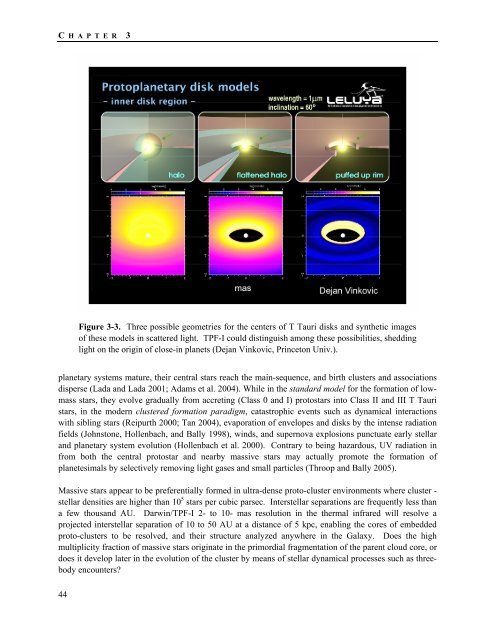TPF-I SWG Report - Exoplanet Exploration Program - NASA
TPF-I SWG Report - Exoplanet Exploration Program - NASA
TPF-I SWG Report - Exoplanet Exploration Program - NASA
You also want an ePaper? Increase the reach of your titles
YUMPU automatically turns print PDFs into web optimized ePapers that Google loves.
C HAPTER 3<br />
Figure 3-3. Three possible geometries for the centers of T Tauri disks and synthetic images<br />
of these models in scattered light. <strong>TPF</strong>-I could distinguish among these possibilities, shedding<br />
light on the origin of close-in planets (Dejan Vinkovic, Princeton Univ.).<br />
planetary systems mature, their central stars reach the main-sequence, and birth clusters and associations<br />
disperse (Lada and Lada 2001; Adams et al. 2004). While in the standard model for the formation of lowmass<br />
stars, they evolve gradually from accreting (Class 0 and I) protostars into Class II and III T Tauri<br />
stars, in the modern clustered formation paradigm, catastrophic events such as dynamical interactions<br />
with sibling stars (Reipurth 2000; Tan 2004), evaporation of envelopes and disks by the intense radiation<br />
fields (Johnstone, Hollenbach, and Bally 1998), winds, and supernova explosions punctuate early stellar<br />
and planetary system evolution (Hollenbach et al. 2000). Contrary to being hazardous, UV radiation in<br />
from both the central protostar and nearby massive stars may actually promote the formation of<br />
planetesimals by selectively removing light gases and small particles (Throop and Bally 2005).<br />
Massive stars appear to be preferentially formed in ultra-dense proto-cluster environments where cluster -<br />
stellar densities are higher than 10 5 stars per cubic parsec. Interstellar separations are frequently less than<br />
a few thousand AU. Darwin/<strong>TPF</strong>-I 2- to 10- mas resolution in the thermal infrared will resolve a<br />
projected interstellar separation of 10 to 50 AU at a distance of 5 kpc, enabling the cores of embedded<br />
proto-clusters to be resolved, and their structure analyzed anywhere in the Galaxy. Does the high<br />
multiplicity fraction of massive stars originate in the primordial fragmentation of the parent cloud core, or<br />
does it develop later in the evolution of the cluster by means of stellar dynamical processes such as threebody<br />
encounters<br />
44
















